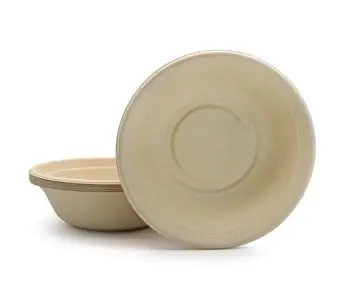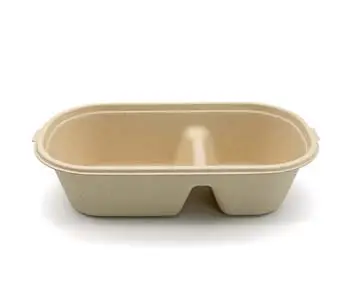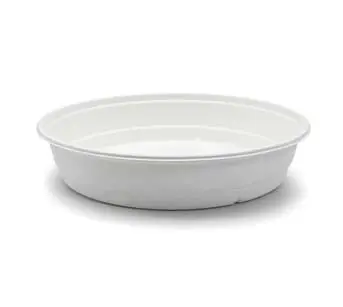Introduction
When it comes to modern-day convenience, microwavable disposable plates have become a staple in many households. These plates are specifically designed to cater to the fast-paced lifestyles of individuals and families alike. With their ability to withstand the heat of a microwave, microwavable disposable plates offer unparalleled convenience and efficiency, making them an ideal choice for those seeking quick and easy meal solutions.
A Brief Overview of Microwavable Disposable Plates
Microwavable disposable plates are lightweight, single-use dinnerware made from various materials such as paper, plastic, or foam. They are designed specifically to be used in microwaves without any risk of melting, warping or releasing harmful chemicals into food. The composition of these plates ensures that they can withstand the high temperatures generated by microwaves while maintaining their structural integrity.
The Importance and Convenience of Using Microwavable Disposable Plates
The importance and convenience offered by microwavable disposable plates cannot be overstated. In today's busy world, time is a precious commodity that we all strive to save. These plates provide an incredibly convenient solution for those who are constantly on-the-go or have limited time for meal preparation.
In addition to their time-saving benefits, compostable microwave containers offer an eco-friendly alternative for those looking to reduce waste. These containers not only provide the convenience of microwavable heating but also break down naturally over time, minimizing their impact on the environment. Embracing the versatility of compostable microwave containers allows for a greener and more convenient approach to meal preparation and disposal.
By using microwavable disposable plates, one can effortlessly transition from cooking to serving without the need for extra dishes or extensive cleanup. This not only saves valuable time but also reduces stress associated with post-meal chores.
Moreover, these plates eliminate the need for traditional breakable dinnerware while still ensuring a satisfactory dining experience. Whether you're hosting a casual gathering or simply enjoying a quick solo meal at home, using microwavable disposable plates allows you to savor your food without worrying about breakage or damage.
These versatile plates offer the added benefit of being easily recyclable in many cases, making them an eco-friendly alternative to traditional dinnerware options. Stay tuned for the upcoming sections as we delve into the specifics of microwavable disposable plates, exploring their different types and highlighting safety considerations to help you make informed choices.
Understanding Microwavable Disposable Plates
Definition and Composition of Microwavable Disposable Plates
Microwavable disposable plates refer to single-use dinnerware that is specifically designed to be used in microwaves. These plates are made from various materials such as paper, plastic, or foam, which are chosen for their ability to withstand microwave heat without warping or releasing harmful chemicals into the food.
The composition of these plates varies depending on the material used. For example, paper plates are typically made from a combination of wood pulp and a thin layer of polyethylene or wax coating to enhance their resistance to moisture and heat.
Plastic plates can be composed of different types of plastics such as polypropylene (PP), polystyrene (PS), or high-density polyethylene (HDPE). Foam plates are manufactured using expanded polystyrene (EPS) foam, which provides insulation and heat resistance properties.
Material Options: Paper, Plastic, or Foam
When it comes to microwavable disposable plates, there are three primary material options available: paper, plastic, and foam. Each material has its own unique characteristics that may suit different preferences and needs.
Paper plates are often favored for their eco-friendliness as they can be easily composted or recycled. They offer sufficient rigidity for regular meal usage but may not hold up well with wet or greasy foods due to their absorbent nature.
Plastic plates provide greater durability and sturdiness compared to paper plates. They can resist liquids better and are less likely to buckle under the weight of heavier meals.
However, it is essential to choose microwave-safe plastic options marked with "microwave safe" symbols. Foam plates possess excellent insulation properties that help maintain food temperature while protecting your hands from burns.
They also have a lightweight design that makes them easy to handle. However, foam plates are not as environmentally friendly as paper or plastic plates, as they are not easily recyclable.
Key Features That Make Them Suitable for Microwave Use
Microwavable disposable plates come with specific features that make them safe and suitable for use in microwaves. These features often include designs that can withstand heat and prevent plate deformation, coatings or materials that do not release harmful chemicals when exposed to high temperatures, and appropriate thickness to ensure even heating without compromising the structure of the plate.
For those seeking both convenience and sustainability, biodegradable microwave safe containers offer a viable solution. These containers have been designed with the same safety features as microwavable disposable plates, ensuring that they can withstand the heat and provide a reliable and eco-friendly option for heating and enjoying meals. With biodegradable materials, these containers promote responsible waste management and make it easier for individuals to make environmentally conscious choices.
Additionally, these plates may incorporate ridges or sections to help distribute heat evenly and prevent food from becoming excessively hot in certain areas. It is crucial to select plates specifically labeled as microwave-safe to avoid accidents or potential health hazards related to using unsuitable materials in the microwave.
Advantages of Microwavable Disposable Plates
Convenience and Time-Saving Benefits for Busy Individuals or Families
One of the primary advantages of microwavable disposable plates is the convenience they offer, particularly for busy individuals or families. In today's fast-paced world, time is a precious commodity, and anything that can save time in our daily routines is highly valued. Microwavable disposable plates eliminate the need for washing dishes, which can be a significant time-consuming task.
After a quick meal or snack, these plates can be disposed of without requiring any additional effort or cleanup. This not only reduces the overall workload but also allows individuals to spend their valuable time on more important tasks or simply relax and enjoy their free time.
Cost-Effectiveness Compared to Traditional Dinnerware
In addition to convenience, microwavable disposable plates offer cost-effectiveness when compared to traditional dinnerware. Traditional dinnerware often comes with a higher price tag due to their quality and durability requirements over an extended period. On the other hand, microwavable disposable plates are typically more affordable since they are designed for single-use purposes.
This makes them an excellent choice for those on a tight budget or hosting large gatherings where multiple plates are needed. Moreover, using disposable plates eliminates the risk of breakage or damage that may occur with delicate china or glassware, saving potential replacement costs.
Eco-Friendly Options Available for Sustainability-Conscious Consumers
As sustainability becomes increasingly important in our society, eco-friendly options within the realm of microwavable disposable plates have also emerged. Many manufacturers now produce environmentally conscious alternatives made from biodegradable materials such as recycled paper or compostable plant-based plastics. These eco-friendly options reduce environmental impact by decomposing naturally and minimizing waste generation compared to traditional plastic alternatives.
Sustainability-conscious consumers can enjoy the convenience of microwavable disposable plates while also making a positive contribution to environmental preservation. By choosing these eco-friendly options, individuals can align their lifestyle choices with their values and contribute to a greener future.
Overall, the advantages of microwavable disposable plates are multifaceted. They offer time-saving benefits, cost-effectiveness, and environmentally friendly options that cater to the needs and preferences of today's fast-paced world.
Whether it is for quick meals on busy weekdays or large gatherings with multiple guests, these plates provide a practical solution without sacrificing quality or style. With the availability of eco-friendly alternatives, individuals can embrace this modern dining option while minimizing their ecological footprint.
Exploring Different Types of Microwavable Disposable Plates
Paper Plates:
Paper plates are a popular choice for those seeking convenience and sustainability. These plates are typically made from a combination of paper fibers and a thin layer of polyethylene or wax coating to enhance their strength and resistance to moisture. The manufacturing process involves pulping the wood fibers, pressing them into thin sheets, and then shaping them into plate form using high-pressure molds.
Paper plates come in various sizes, ranging from small dessert plates to larger dinner-sized options, providing flexibility for different types of meals. Additionally, they offer a wide array of design options, including plain white, patterned prints, or even custom designs for special occasions.
Plastic Plates:
Plastic plates have gained popularity due to their durability and versatility. When it comes to microwave-safe plastic plates, it is crucial to ensure they are labeled as such by the manufacturer.
These plates are commonly made from polypropylene (PP) or high-heat resistant polystyrene (PS). Polypropylene is known for its heat resistance and ability to withstand frequent use without warping or melting when used in microwaves within the recommended temperature limits.
On the other hand, polystyrene offers excellent insulation properties while maintaining its structural integrity under heat exposure. Plastic plates come in various shapes and sizes similar to their paper counterparts but often offer additional features like compartments for separating different food items during meals.
Foam Plates:
Foam plates provide unique advantages that make them suitable for microwave use while ensuring convenient disposal afterwards. These plates are manufactured using expandable polystyrene foam (EPS), which is created by expanding tiny beads of polystyrene with steam until they fuse together into a solid form with air pockets distributed throughout the material's structure. This composition gives foam plates excellent heat insulation properties, allowing them to remain cool to the touch even when heated in a microwave.
Additionally, the air pockets within the foam help distribute heat evenly, reducing the risk of hot spots or uneven heating. Foam plates are available in various sizes and shapes, including round, square, and compartmentalized options, catering to different dining preferences.
Overall, each type of microwavable disposable plate offers distinct characteristics that cater to various needs and preferences. From the eco-friendly nature of paper plates to the durability of plastic options and the heat insulation provided by foam plates, consumers have a wide range of choices when it comes to finding the perfect microwave-safe disposable plate for their specific requirements.
Microwave Safety Considerations with Disposable Plates
Tips for Safe Usage: Avoiding Overheating or Melting
Microwavable disposable plates offer convenience and time-saving benefits, but it is essential to use them safely to avoid any potential hazards. When using these plates in the microwave, it is crucial to follow a few simple tips to ensure that they do not overheat or melt.
Firstly, it is important to adhere to the recommended time and power settings mentioned on the packaging of the disposable plates. Overheating can occur if you exceed the suggested time or use a higher power setting than recommended.
Secondly, avoid stacking multiple plates on top of each other as this can hinder proper heat distribution and lead to uneven heating. Additionally, be mindful of hotspots that may form on the plate during microwaving; use oven mitts or heat-resistant gloves when handling hot plates to prevent burns.
Guidelines on Choosing the Right Plate Thickness for Specific Foods
While microwavable disposable plates are designed for safe microwave use, it is important to consider their thickness when selecting them for specific types of food. Different foods require different levels of heating, and choosing an appropriate plate thickness can help achieve optimal results without compromising safety.
For lighter foods that heat quickly such as leftovers or snacks, thinner disposable plates can be suitable as they allow for better heat penetration and even cooking. On the other hand, thicker plates are more suitable for heavier dishes like casseroles or meals requiring longer cooking times as they provide better insulation and prevent scorching or overheating in some areas.
It is advisable to check manufacturer recommendations regarding plate thickness based on food types for optimal performance. Overall, by following these tips for safe usage and considering plate thickness guidelines based on food types, individuals can ensure a seamless experience while using microwavable disposable plates without compromising safety or the quality of their meals.
Creative Uses Beyond the Microwave
Party Planning: Using Microwavable Disposable Plates for Outdoor Events
When it comes to hosting outdoor events, microwavable disposable plates offer a practical and convenient solution. Whether you're organizing a backyard barbecue, picnic in the park, or a poolside party, these plates provide an excellent alternative to traditional dinnerware.
Their lightweight and portable nature make them easy to transport and set up in any outdoor setting. Additionally, their sturdy construction ensures that they can withstand the rigors of outdoor use without fear of breakage.
Available in various sizes and designs, microwavable disposable plates allow you to add a touch of style to your event while ensuring easy cleanup afterwards. So, go ahead and serve your guests with confidence, enjoying the festivities without worrying about delicate dishes.
Craft Projects: Repurposing Used Disposable Plates into Decorative Items
Don't be so quick to toss out those used microwavable disposable plates after your meal! They can be transformed into unique decorative items through creative craft projects.
Let your imagination run wild as you repurpose these plates into stunning pieces of art or functional objects. For instance, cut out different shapes from the plates and create a vibrant mosaic that can be framed as wall decor or used as a centerpiece for special occasions.
Alternatively, you can experiment with folding techniques to craft beautiful origami-inspired paper bowls or create intricate 3D sculptures by layering and manipulating the plates' edges. The possibilities are endless when it comes to breathing new life into these seemingly ordinary items.
Embrace sustainability while indulging in artistic expression by exploring the countless craft project ideas that microwavable disposable plates have to offer. By thinking outside the box and considering innovative uses for microwavable disposable plates beyond their primary purpose, you can truly maximize their value and inject creativity into various aspects of your life.
Alternatives to Microwavable Disposable Plates
Reusable microwave-safe dinnerware options
When considering alternatives to microwavable disposable plates, one excellent option is investing in reusable microwave-safe dinnerware. These are typically made from materials like glass, ceramic, or certain types of plastic that can withstand the heat of the microwave without warping or releasing harmful chemicals. Reusable dinnerware offers a more sustainable and environmentally-friendly solution compared to their disposable counterparts.
They are durable and long-lasting, reducing waste generated from repeatedly using disposable plates. Additionally, these plates often come in a wide range of designs and styles, allowing individuals to showcase their personal taste while still enjoying the convenience of microwave use.
Eco
For those concerned about the environmental impact of using microwavable disposable plates, it is worth exploring eco-friendly alternatives. One popular option is compostable plates made from materials such as bamboo or palm leaf. These natural materials break down easily in composting systems without releasing harmful toxins into the environment.
Furthermore, some companies offer reusable plastic plates made from recycled materials like BPA-free polypropylene or even biodegradable plastic alternatives like PLA (polylactic acid). By choosing these eco-conscious options, consumers can actively contribute to reducing waste and minimizing their carbon footprint.
Conclusion
While microwavable disposable plates offer convenience and time-saving benefits, it is essential to consider alternative options that prioritize sustainability and environmental responsibility. Reusable microwave-safe dinnerware provides a long-term solution for individuals seeking durability and style without compromising on their ability to heat food quickly in a microwave oven.
Eco-friendly alternatives such as compostable plates or recycled plastic options encompass both convenience and conscience by mitigating harm to the planet through reduced waste generation. By making informed choices about our dining habits, we can take small yet impactful steps towards a more sustainable future.




